Saturday, October 03, 2015
Sacred math, secular math 2
Following from this piece on Sacred and Secular Math.
This thought was specifically triggered by my comparison of a supposedly 'starving' prison diet placed in a 4x6 inch plate, vs my normal 8" diameter bowl. At first I made a dumb error, figuring the bowl's area as pi x diameter, which gave the same value as the 4x6 rectangle. Quickly realized that pi x D is circumference. If my bowl was a cylinder, and if I filled it all the way, my meal would certainly beat the prison meal; but the actual volume probably comes out the same because the bowl is a flattened paraboloid, not a cylinder.
This error was TOO EASY. Why?
It's sacred vs secular. Our official math doesn't serve the purposes of real-life work and play.
Nearly everything in ordinary cooking is round, not rect. In the kitchen we judge volume and area by cylinders, cone frustums, hemispheres and paraboloids.
Only a very few things are rectangular. Some cake pans and roasting pans. Fresh food is mainly sphere-like or egg-like as it goes into the pan.
Just for fun, here's a geometrical recipe for my daily chili-like substance. I've written an earlier version of this recipe, but I've tanh'd it since then into an asymptotically yummy form. At least in theory, the latest form is also respectful of smarty-plants. Everything in it comes from the separable fruits and flowers that plants intend to give us. No squares, no roots.
1. Start with an inch of water in a cylinder.
 2. Add 3 heaping tablespoons of precooked barley spheres from a cone-frustum. (Note that a heaping T is an egg shape.)
2. Add 3 heaping tablespoons of precooked barley spheres from a cone-frustum. (Note that a heaping T is an egg shape.)
 3. Add 3 egg shapes of kidney-bean spheroids from a cylinder. (I don't actually use the spoon for this; I just pour out about 1/3 of the cylinder.)
3. Add 3 egg shapes of kidney-bean spheroids from a cylinder. (I don't actually use the spoon for this; I just pour out about 1/3 of the cylinder.)
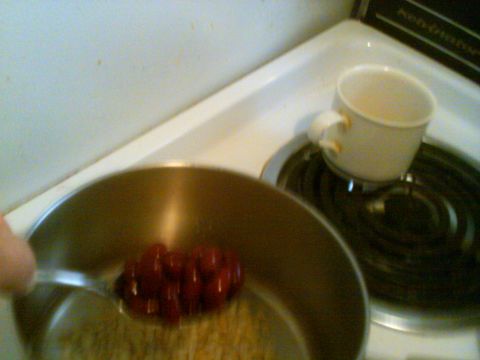 4. Cut up a hemisphere of tomato and a one-inch cylinder of zucchini on a ceramic circle.
4. Cut up a hemisphere of tomato and a one-inch cylinder of zucchini on a ceramic circle.
 Tip: If you make the tomato pieces close to equilateral triangles, they will retain their skin while cooking. If you cut them into long narrow strips as for a sandwich, the skin will curl up and separate.
Tip: If you make the tomato pieces close to equilateral triangles, they will retain their skin while cooking. If you cut them into long narrow strips as for a sandwich, the skin will curl up and separate.
 5. Use hot water to thaw about this much broccoli spheres and cauliflower spheres in a paraboloid.
5. Use hot water to thaw about this much broccoli spheres and cauliflower spheres in a paraboloid.
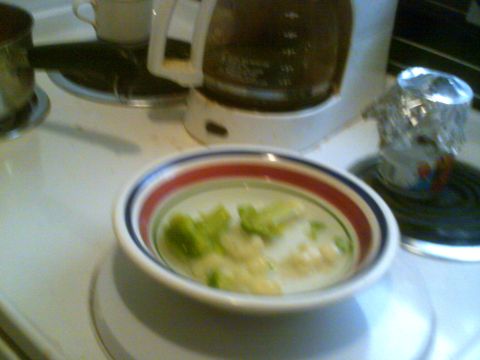 6. Add salt and chili powder from cylinders.
6. Add salt and chili powder from cylinders.
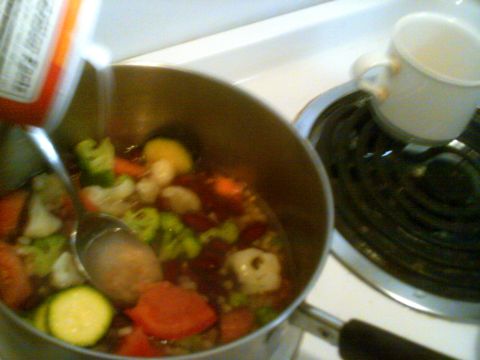 Tip: the best way to shake from this particular cylinder is nearly upright, shaking sideways. If you try to hold it upside down, you end up blocking the circular holes with damp powder.
Tip: the best way to shake from this particular cylinder is nearly upright, shaking sideways. If you try to hold it upside down, you end up blocking the circular holes with damp powder.
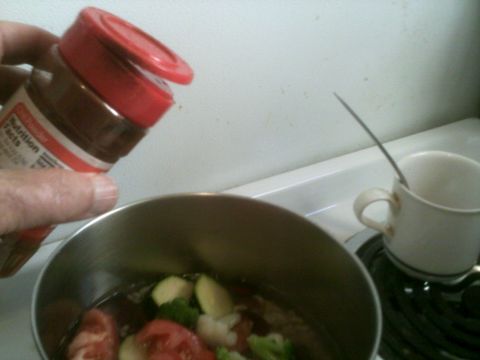 7. Low boil for about 5 minutes.
8. Add an amorphous glob of tomato paste from a cylinder. I also add some water to make the result a little more 'soupy', attempting to approximate the original inspiration for this chili.
7. Low boil for about 5 minutes.
8. Add an amorphous glob of tomato paste from a cylinder. I also add some water to make the result a little more 'soupy', attempting to approximate the original inspiration for this chili.
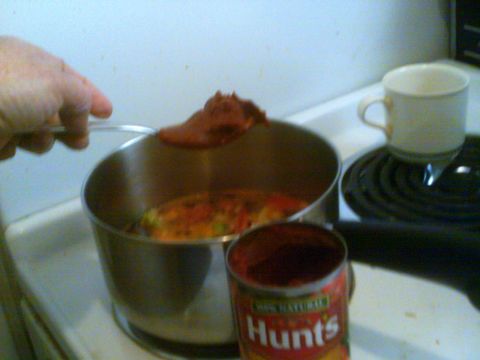 9. Turn down heat, let simmer for about 10 minutes with a couple of stirs.
10. Result: Two paraboloids of pure yum. I could probably fit it all in one paraboloid, but splitting it makes me eat slower and also avoids possible spills.... though I've carried this paraboloid back and forth from the kitchen rectangle to the living rectangle for 25 years = approx. 30000 times, with no spills YET.
9. Turn down heat, let simmer for about 10 minutes with a couple of stirs.
10. Result: Two paraboloids of pure yum. I could probably fit it all in one paraboloid, but splitting it makes me eat slower and also avoids possible spills.... though I've carried this paraboloid back and forth from the kitchen rectangle to the living rectangle for 25 years = approx. 30000 times, with no spills YET.
 All of these things are spherical or cylindrical. Our visual perception, tactile feel, and muscle weight sensors work together nicely with these shapes. If you assume that we began as tree dwellers mainly eating fruit and nuts, it makes sense to assume we're designed for spheres and cylinders.
Nothing in nature is rectangular or cubic. Absolutely nothing. Yet all of our area and volume measurements are squares and cubes. Square and cube units are appropriate for houses, but not much else.
There SHOULD be a solution to this sacred/secular problem. I don't have it!
All of these things are spherical or cylindrical. Our visual perception, tactile feel, and muscle weight sensors work together nicely with these shapes. If you assume that we began as tree dwellers mainly eating fruit and nuts, it makes sense to assume we're designed for spheres and cylinders.
Nothing in nature is rectangular or cubic. Absolutely nothing. Yet all of our area and volume measurements are squares and cubes. Square and cube units are appropriate for houses, but not much else.
There SHOULD be a solution to this sacred/secular problem. I don't have it!
 2. Add 3 heaping tablespoons of precooked barley spheres from a cone-frustum. (Note that a heaping T is an egg shape.)
2. Add 3 heaping tablespoons of precooked barley spheres from a cone-frustum. (Note that a heaping T is an egg shape.)
 3. Add 3 egg shapes of kidney-bean spheroids from a cylinder. (I don't actually use the spoon for this; I just pour out about 1/3 of the cylinder.)
3. Add 3 egg shapes of kidney-bean spheroids from a cylinder. (I don't actually use the spoon for this; I just pour out about 1/3 of the cylinder.)
 4. Cut up a hemisphere of tomato and a one-inch cylinder of zucchini on a ceramic circle.
4. Cut up a hemisphere of tomato and a one-inch cylinder of zucchini on a ceramic circle.
 Tip: If you make the tomato pieces close to equilateral triangles, they will retain their skin while cooking. If you cut them into long narrow strips as for a sandwich, the skin will curl up and separate.
Tip: If you make the tomato pieces close to equilateral triangles, they will retain their skin while cooking. If you cut them into long narrow strips as for a sandwich, the skin will curl up and separate.
 5. Use hot water to thaw about this much broccoli spheres and cauliflower spheres in a paraboloid.
5. Use hot water to thaw about this much broccoli spheres and cauliflower spheres in a paraboloid.
 6. Add salt and chili powder from cylinders.
6. Add salt and chili powder from cylinders.
 Tip: the best way to shake from this particular cylinder is nearly upright, shaking sideways. If you try to hold it upside down, you end up blocking the circular holes with damp powder.
Tip: the best way to shake from this particular cylinder is nearly upright, shaking sideways. If you try to hold it upside down, you end up blocking the circular holes with damp powder.
 7. Low boil for about 5 minutes.
8. Add an amorphous glob of tomato paste from a cylinder. I also add some water to make the result a little more 'soupy', attempting to approximate the original inspiration for this chili.
7. Low boil for about 5 minutes.
8. Add an amorphous glob of tomato paste from a cylinder. I also add some water to make the result a little more 'soupy', attempting to approximate the original inspiration for this chili.
 9. Turn down heat, let simmer for about 10 minutes with a couple of stirs.
10. Result: Two paraboloids of pure yum. I could probably fit it all in one paraboloid, but splitting it makes me eat slower and also avoids possible spills.... though I've carried this paraboloid back and forth from the kitchen rectangle to the living rectangle for 25 years = approx. 30000 times, with no spills YET.
9. Turn down heat, let simmer for about 10 minutes with a couple of stirs.
10. Result: Two paraboloids of pure yum. I could probably fit it all in one paraboloid, but splitting it makes me eat slower and also avoids possible spills.... though I've carried this paraboloid back and forth from the kitchen rectangle to the living rectangle for 25 years = approx. 30000 times, with no spills YET.
 All of these things are spherical or cylindrical. Our visual perception, tactile feel, and muscle weight sensors work together nicely with these shapes. If you assume that we began as tree dwellers mainly eating fruit and nuts, it makes sense to assume we're designed for spheres and cylinders.
Nothing in nature is rectangular or cubic. Absolutely nothing. Yet all of our area and volume measurements are squares and cubes. Square and cube units are appropriate for houses, but not much else.
There SHOULD be a solution to this sacred/secular problem. I don't have it!
All of these things are spherical or cylindrical. Our visual perception, tactile feel, and muscle weight sensors work together nicely with these shapes. If you assume that we began as tree dwellers mainly eating fruit and nuts, it makes sense to assume we're designed for spheres and cylinders.
Nothing in nature is rectangular or cubic. Absolutely nothing. Yet all of our area and volume measurements are squares and cubes. Square and cube units are appropriate for houses, but not much else.
There SHOULD be a solution to this sacred/secular problem. I don't have it!
Labels: coot-proofing, Metrology, Smarty-plants
